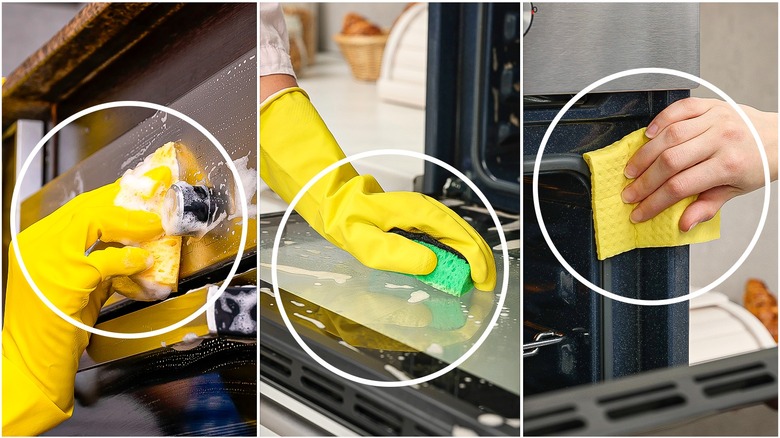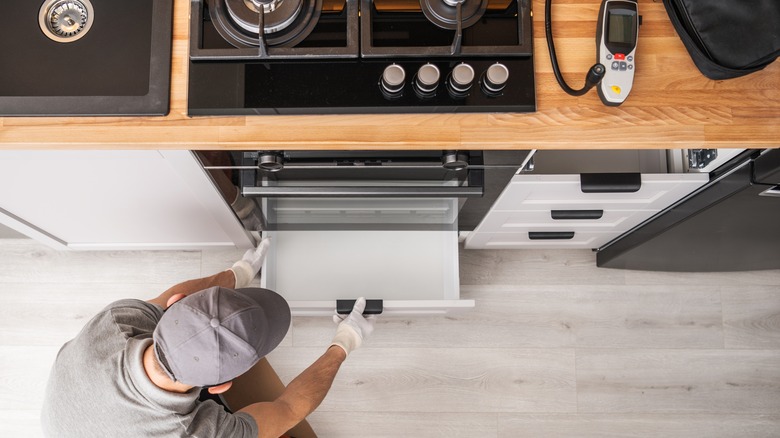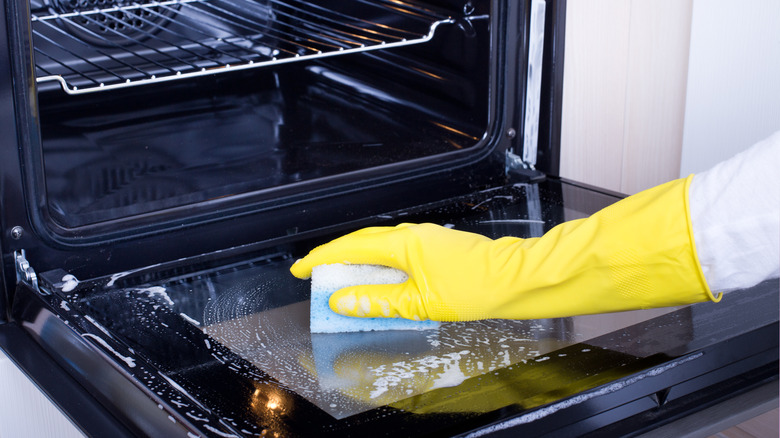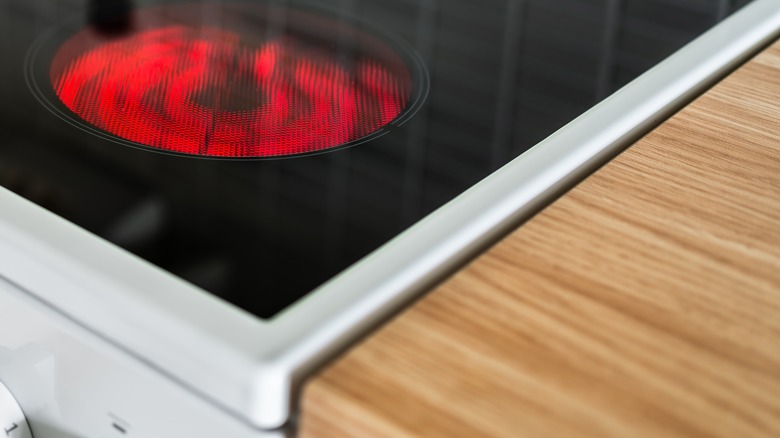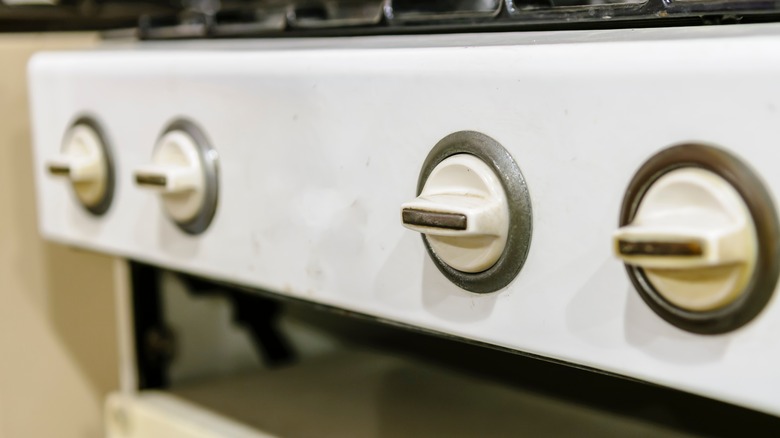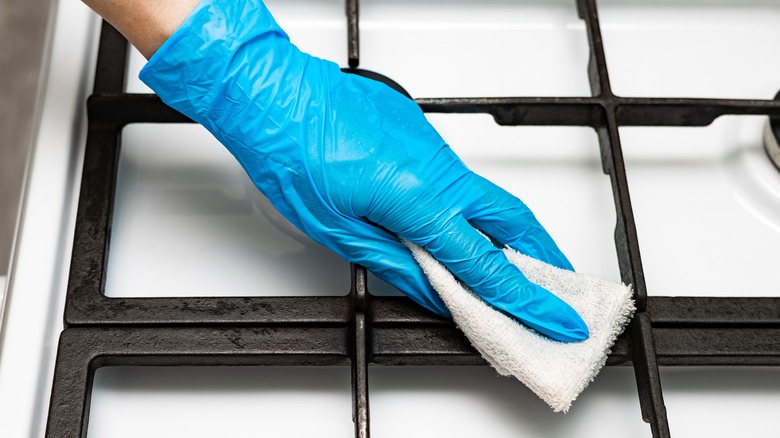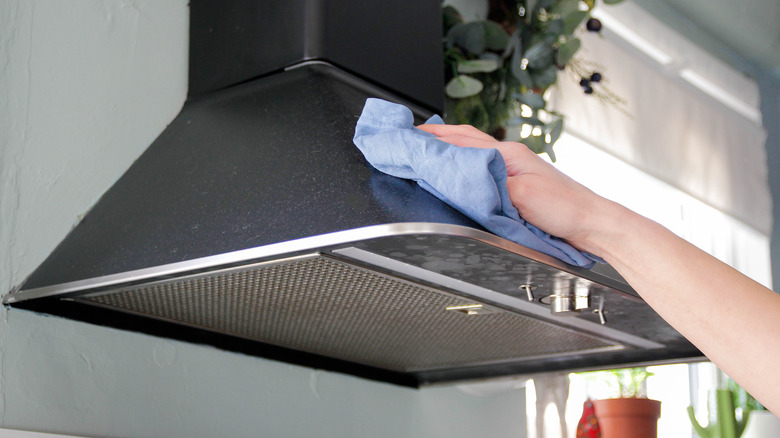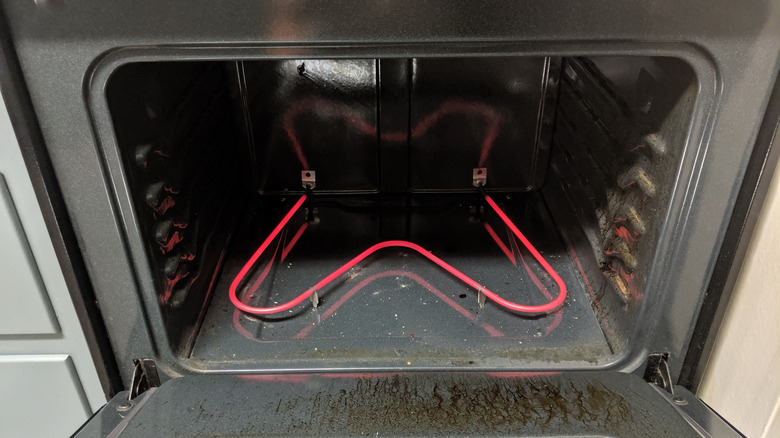8 Spots In Your Oven You're Forgetting To Clean
We may receive a commission on purchases made from links.
Knowing how to clean the oven in your home seems simple, but for many people, that means only cleaning the top of the stove and the main oven cavity with some oven cleaner or using the self clean function. There's actually a lot more that you have to do if you want to ensure that you're cleaning your oven properly. Some of these tasks are ones you do every few months, but others need attention more frequently.
Taking care of these cleaning tasks can often eliminate other problems you may have been experiencing. If you've had strange odors in your kitchen that don't seem to be coming from the garbage or sink drain, the area around your oven could be the culprit. If you just can't seem to get rid of some stains on the door, it could be you didn't know that stains could form inside the door between the glass panes. Here's a look at eight spots in and around your oven that you're forgetting to clean.
Under and behind the oven
If you've ever been preparing food and dropped something like a frozen pea, only to never find it again, it might be hiding under your oven. The floor under the oven is often filled with food debris that can attract pests and make the kitchen smell no matter how well you clean it everywhere else. Cleaning the floor under the oven usually requires sweeping or vacuuming, as you would cleaning the rest of the floor in the kitchen.
Accessing the floor may seem impossible to someone who's never tried to clean it, but there are two things you can do. One is to pull out the oven from the wall and clean what you can, but another is to pull out the drawer at the bottom, if your model allows that. That should expose all of the floor space. Sometimes, the oven doesn't have an actual drawer but instead has a panel on the front that detaches, exposing an empty space.
That weird drawer at the bottom
So, about that drawer at the bottom of the oven ... No one who isn't a manufacturer seems to be able to figure out if it is for storage, warming food, or what. This is understandable, given that the purpose of the drawer really does vary by the type of fuel source, the oven's design, and the manufacturer. In some cases, that drawer is even where the broiler is. Homeowners who bought their own oven can check the manual that came with it; renters can try to find the oven's manual online or speak with their landlord or maintenance crew. Regardless of its purpose, you do need to clean the drawer.
Every few months, pull the drawer out and wipe down the interior surfaces. Do this more often if the drawer is a warming drawer or broiler that you actually use. Remember to remove all cleaning solution residue before using the drawer again.
Between the glass panes in the door
The glass pane in an oven door looks so much better when it's clean, and wiping down both sides of the glass is easy. But what a lot of people don't realize is that many ovens have two panes of glass, and grease can seep in between them.
To completely clean the glass panes, start by using a mild, non-abrasive cleaner on the interior and exterior sides. Next, remove the door. It should have gaps in the bottom that let you access the glass with something thin like a stick or wire with a cloth attached to it. After adding a little cleaning solution to the cloth, you should be able to insert the contraption through the gaps into the door. Wipe the glass carefully, and repeat the process with cloths that you dampen only with water, and then with dry cloths to ensure all of the cleaning solution has been removed.
The sides of the oven
Whether your oven sits between two counters or sits out in the open, you've got to give its sides some care. Food can drip into the gap between the oven and counter and leave streaks that can start to smell or attract dirt.
Cleaning oven grime is easy for sides that aren't blocked by anything, of course. Take your favorite mild cleaner and scrub away at the spill with a paper towel or soft cloth. But for sides that are usually blocked by base cabinets or other appliances like the refrigerator, you'll have to pull out the oven to access them. If you live in a rental, you may want to speak with your landlord or building manager before doing this. You can also use a thin broom or a yardstick with a cloth wrapped around it (with cleaner sprayed onto the cloth) and stick it into the gap to give the oven's side a quick once-over.
One solution to prevent the sides of your oven from getting dirty in the first place is to purchase silicone gap covers to block the space between the oven and the counter. Remember not to block off the entire gap because that could affect the oven's heat dissipation and ventilation; appliances that give off heat need clearance.
The temperature knobs
The knobs that let you regulate stove and oven temperatures need to be cleaned, even if they look like they're out of the way of any splattering food. They're not — those splatters manage to get everywhere, and if grease builds up on the knobs, it will attract dirt.
When you do clean the knobs, never spray a cleaning solution directly onto them. The liquid can seep behind the knobs. If the liquid cleaner gets into the control panel behind the knob, it could damage the controls. Instead, add the cleaner to the cloth or paper towel you're using. Spray the cleaner on the cloth or dip the cloth into the cleaning solution, then clean the knobs.
Also, if the knobs detach — on many models, you can pull them off and push them on again — remove them and carefully clean the space behind them. Soak the knobs in a mix of vinegar and water and dry them thoroughly before reinstalling them. Also, be very careful not to use harsh cleaners on printed numbers such as temperature markings as those can come off easily.
Stovetop grates (if the oven has a gas range)
One place people often forget to clean is the grates that sit over a gas burner. Drips and spatters of food can build up on them and make them look gross. Stove grates aren't something that you need to deep-clean every week; you can usually clean off fresh spills with a damp paper towel and maybe a little dishwashing liquid or baking soda. But if you don't clean the grates for a long time, the buildup can become very tough to remove and make your stove and oven look like they're in poor condition.
Cleaning the grates isn't that difficult; it just takes time and some effort. You also don't need to use ammonia, which was once the go-to cleaning solution for cast iron grates. Enameled grates can be cleaned with baking soda paste and grease-fighting dishwashing liquid, along with hot water and a stiff-bristled brush. Don't use baking soda paste on non-enameled grates.
Be sure the grates are cool before cleaning them, and dry them with paper towels or a microfiber cloth. If the debris is really caked on and won't come off, you could try using an oven cleaner on them. However, be sure to wipe away all the residue with hot water and dish soap.
The range hood and filter
If you have a combination oven and stove, you also likely have a range hood with a filter. Some stoves in older structures don't have this (ventilation in older apartments and homes often uses an exhaust fan in the wall or an open duct leading up to the roof), and many stoves/ovens have microwaves sitting over the stove instead. But if you have a range hood, you have to clean it regularly to remove grease that builds up over time. That grease attracts dirt and dust, and it can look terrible and hold onto smells.
The exterior usually just needs a degreasing cleaner and a soft cloth or paper towel. The filter itself just needs to soak in hot, soapy water. Then scrub it with a soft brush, rinse it, and dry it. If the grease is really bad, the oven cleaner trick mentioned for stove grates is an option.
What about using paper filters over the regular filter? You can buy disposable filters that sit next to the mesh filter; these are usually held onto the hood with clips. The idea is that these filters will catch most of the grease and dirt, making it less likely you'll have to clean the actual filter. While these may be helpful to an extent, they may also restrict airflow into the actual filter and vent, so use them with caution.
Oven heating elements and gas burners
If you've never realized that cleaning your oven's heating elements and broiler was a thing, that's fine. You normally don't have to clean them because the heat from cooking burns off most dust and dirt. Most of the time, you will only need to lift up the hinged electric elements (in those ovens that have them) to gain better access to the floor of the oven to clean that area.
Where cleaning the elements and burners really matters is when you spill food or spray cleaning solutions on them. Many cleaning solutions are flammable, and even those that aren't flammable can make any food you bake in the oven smell terrible. If you spill or spray a cleaning solution on an oven heating element, wipe it carefully with a damp paper towel, and don't use the oven again until you've thoroughly removed all the residue.
